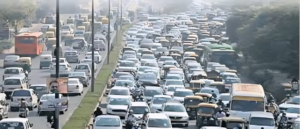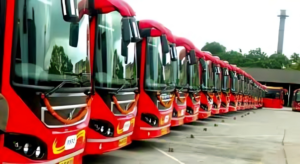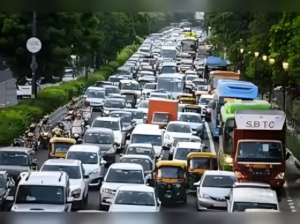Delhi’s Unified Metropolitan Transport Authority: A Game-Changer to Untangle City Traffic Woes
Introduction
Delhi, a bustling metropolis of over 20 million people, has long grappled with crippling traffic congestion. Fragmented planning, siloed agencies, and rapid urbanization have left commuters stuck in endless jams and facing unreliable public transport options. Recognizing these challenges, the Delhi government has greenlit the formation of a Unified Metropolitan Transport Authority (UMTA). This single umbrella body promises to bring coherence to planning, streamline project execution, and ultimately steer the city toward a more efficient, sustainable and commuter-friendly transport ecosystem.

Delhi Game-Changer to Untangle City Traffic Woes
The Need for a Unified Body
Fragmented Transport Landscape
- Multiple Agencies, Multiple Plans
Delhi’s transport network is managed by a host of agencies—DMRC (Delhi Metro Rail Corporation), Delhi Transport Department, DTC (Delhi Transport Corporation), the upcoming RRTS (Rapid Regional Transport System), traffic police, and more. Each agency drafts its own timelines, budgets, and routes, often leading to:- Overlap in project scopes
- Delays due to inter-agency disputes
- Funding bottlenecks when responsibilities blur
- Commuter Frustrations
Imagine a suburban resident who needs to switch from metro to bus to reach work. Inconsistent schedules, disconnected routes, and lack of a unified ticketing system make even short journeys unpredictable.
Rising Demand, Limited Coordination
As Delhi expands—new residential hubs, satellite towns, and commercial districts—the demand for a cohesive, city-wide transport strategy has never been higher. Without a central authority:
- Long‑term planning takes a backseat to short‑term fixes.
- Road safety innovations, such as pedestrian zones and dedicated bike lanes, remain piecemeal.
- Last‑mile connectivity suffers, discouraging many from switching to public transport entirely.
How UMTA Will Transform Mobility
Centralized Planning and Oversight
UMTA’s core mandate is to unify planning under one roof:
- Integrated Timelines: Coordinated project schedules will align metro expansions, bus fleet augmentations, and RRTS rollouts to minimize commuter disruption.
- Unified Budgeting: A central financial pool will reduce duplication and ensure funds reach priority projects swiftly.
- Geographical Integration: UMTA will oversee the entire “Urban Mobility Area,” spanning Delhi and adjoining National Capital Region (NCR) zones, for truly regional planning.
Streamlined Decision‑Making
Faster Approvals
Rather than each agency seeking separate cabinet or ministerial nods, UMTA can fast‑track approvals for crucial initiatives:
- Elevated Ring Road Corridors to decongest key junctions
- Bus Rapid Transit (BRT) Phase‑II, linking underserved localities
- Unified Smart Card roll‑out for seamless transfers across metros, buses, and suburban trains
Conflict Resolution
A dedicated task force will include representatives from:
- Delhi Pollution Control Board
- Traffic Police
- Finance Department
- Urban Development Ministry
This ensures potential conflicts—like funding disputes or environmental clearances—are ironed out before they stall projects.
Fostering Public Transport Adoption
Incentives and Awareness
To shift commuters away from private vehicles, UMTA will:
- Launch awareness campaigns highlighting cost, time, and environmental benefits.
- Partner with ride‑sharing platforms for seamless first‑/last‑mile connectivity.
- Implement congestion pricing on selected corridors during peak hours.
Real‑Life Example: Metro Phase IV Hurdles
Under previous frameworks, the delay in Delhi Metro’s Phase IV funding caused a ripple of postponements, extending project timelines by years. UMTA’s unified funding model could have preempted such hold‑ups, ensuring phases roll out as scheduled, offering commuters relief faster.
Road Safety and Sustainable Mobility
Dedicated Road Safety Wing
While integration is UMTA’s focus, safety will be a cornerstone. A specialized wing will:
- Audit accident‑prone zones and recommend engineering remedies (e.g., improved signage, speed calming measures).
- Coordinate with traffic police to pilot intelligent traffic signal systems.
- Promote pedestrian‑friendly infrastructure—foot overbridges, zebra crossings, dedicated walking zones.
Eco‑Friendly Initiatives
UMTA will champion green mobility by:
- Phasing in electric buses across all major routes within the next five years.
- Expanding cycle‑sharing networks and dedicated cycling lanes, taking cues from global cities like Copenhagen.
- Setting emission reduction targets in coordination with Delhi Pollution Control Board, ensuring transport contributes to cleaner air.

Challenges and the Road Ahead
Ensuring Accountability
A unified body risks becoming yet another bureaucratic layer unless transparency is embedded:
- Public Dashboards: Real‑time project status, budget spend, and performance metrics.
- Third‑Party Audits: Annual reviews by independent agencies to assess efficiency gains and commuter satisfaction.
Bridging the Digital Divide
Seamless technology integration—like mobile apps for real‑time tracking—must account for users across income groups. UMTA’s digital platforms will:
- Offer multi‑language support (English, Hindi, and regional languages).
- Include SMS‑based updates for non‑smartphone users.
- Provide helplines and kiosks in public spaces for route planning assistance.

Conclusion
The establishment of the Unified Metropolitan Transport Authority marks a pivotal moment in Delhi’s transport evolution. By consolidating planning, funding, and execution under a single umbrella, UMTA is poised to:
- Slash commute times through better network integration.
- Enhance safety by proactively addressing accident hotspots.
- Promote sustainable travel via electric fleets and non‑motorized transit options.
For the millions of Delhi commuters, UMTA promises not just smoother travels, but a future where city mobility is reliable, affordable, and green. As the authority takes shape, vigilant public engagement, stringent accountability, and a relentless focus on the user experience will be key to realizing its full potential.